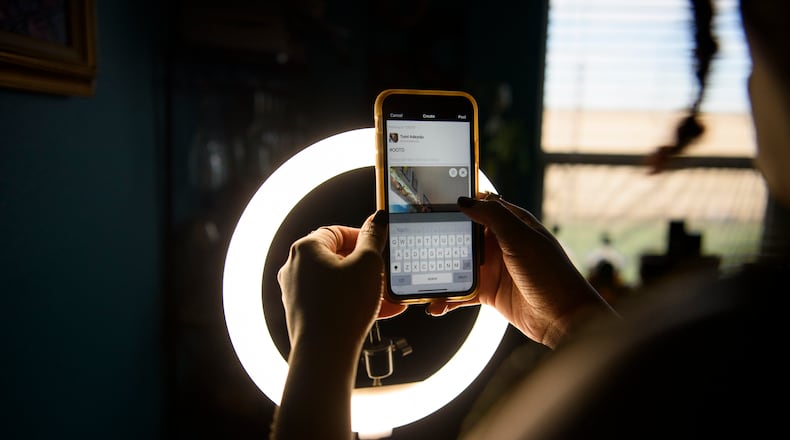In mid-March, police warned residents of Peachtree City that a new crime was on the rise.
Teens were shooting at strangers using pellet guns filled with Orbeez, the popular gel and water-based beads used in children’s toys. An 8-year-old and a 10-year-old had been shot and were injured in the face and abdomen.
The Orbeez Challenge was just the latest in a stream of wacky stunts from the social media platform TikTok.
By the end of the March, Georgia Attorney General Chris Carr had joined a coalition of attorneys general from 44 states in a written request to TikTok and Snapchat calling for the platforms to offer better collaboration with parental control apps or to enhance the parental controls on their own platforms.
The letter stated the need for the platforms to work with apps that would alert parents if kids display potential for self-harm or that would allow parents to restrict explicit content, including any content contained in direct messages.
“Empowering parents is necessary in today’s online environment, a place that can be considerably hostile to our youth,” the letter said.
History is rife with moments when adults have attempted to control teenagers’ access to certain content be it comic books in the 1950s, movies in the 1960s or rap music in the 1990s. The stated intent is always to protect youth from harm and create a national standard to which companies must conform.
Now social media is having its turn in the social responsibility spotlight.
I’m all for regulations but it is important to understand exactly what needs regulating, and adults have a habit of restricting media platforms or content or before we fully comprehend how children are engaging with it. That’s something we can only learn by consulting with kids.
“One thing we see really clearly is a need to move away from sweeping generalizations and focus in on what social media is actually amplifying for different kids. Is it something positive for their mental health or negative?” said Emily Weinstein, Research Director for Project Zero at Harvard Graduate School of Education and co-author of the forthcoming book ”Behind their Screens.”
“The content (teenagers) are seeing can be part of the issue but as important is how they interpret the content. We won’t know that if we are just monitoring behind their backs,” Weinstein said.
For more than a decade, Project Zero has studied teens and screens. After talking to more than 3,500 teens across the country, Weinstein and fellow researcher Carrie James found that adults have a lot to understand about how young people really experience social media.
We tell kids to get off the phone, tablet, computer, or social media platform when they run into trouble, but it isn’t that simple.
Teens know the problems they may experience online do not end on social media. They often spill over into real life.
“Many of us can remember the social dynamics of the middle school lunchroom,” Weinstein said. “This middle school lunchroom is on the screen in front of you all the time with all the social analytics always accessible.”
Social media is designed to hold our attention — infinite scrolling, notifications — but contrary to adult beliefs, some teens don’t want to be on social media all the time and are trying to take control of their social media habits.
“We were blown away by the ways that some teens were finding control even in a context where it was routinely being undercut,” Weinstein said. Teens reported setting parental controls for themselves or physically distancing themselves from their phones. Others said they intentionally curate their feeds with content that is affirming and inspirational.
Another adult assumption is that technology negatively impacts a child’s capacity for empathy. But it is often a deep sense of empathy for one another and the desire to have good friends that contributes to many of the struggles kids are facing as they try to build healthy social media habits, Weinstein said.
“The desire to be a good friend gets pitted against the desire for self-care,” Weinstein said. “How hard must that be?”
Part of the responsibility for finding answers to these questions lies with tech companies. “How do we ensure that companies are prioritizing youth well-being over profit consistently at the outset during the design process but also in an ongoing way?” Weinstein said.
Weinstein gave the example of Venmo, the peer-to-peer payment app that can become a minefield of angst if a teen sees a transaction between friends at the same venue on the same day and realizes they were not invited. Or consider the frustration of a young person whose parents restrict access to certain social media platforms that a coach uses to communicate with a sports team.
These are problems most adults would not even grasp without input from kids and they can’t be addressed by propping up parental controls.
Social media presents some very real concerns for young people. Focusing on what adults believe are the issues instead of the actual problems kids are facing won’t solve them.
Read more on the Real Life blog (www.ajc.com/opinion/real-life-blog/) and find Nedra on Facebook (www.facebook.com/AJCRealLifeColumn) and Twitter (@nrhoneajc) or email her at nedra.rhone@ajc.com.
About the Author
Keep Reading
The Latest
Featured



